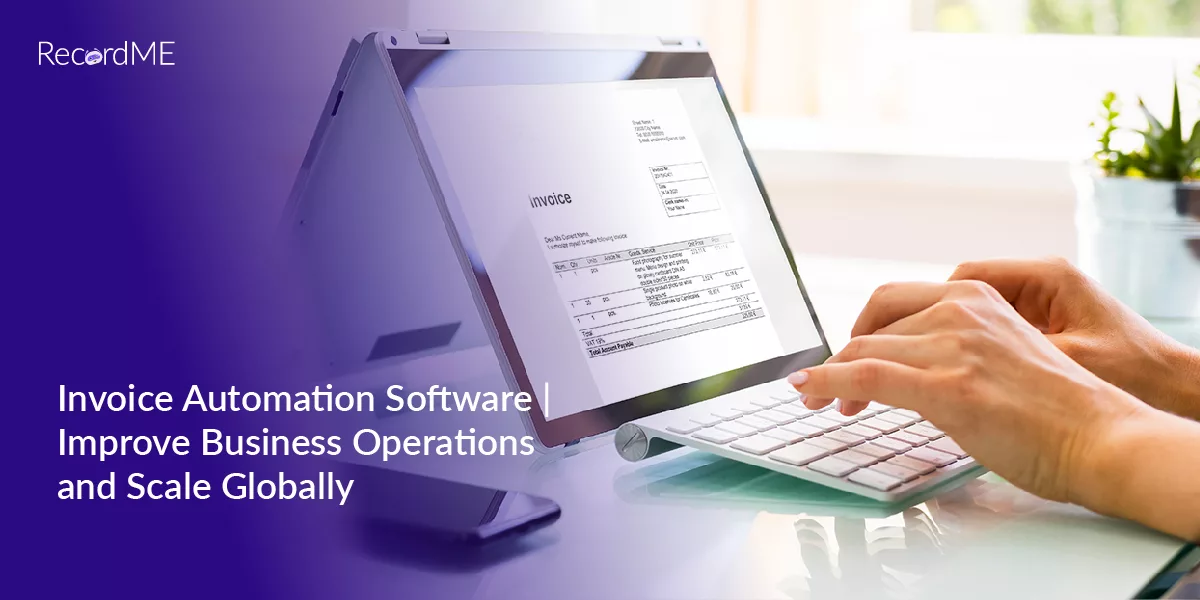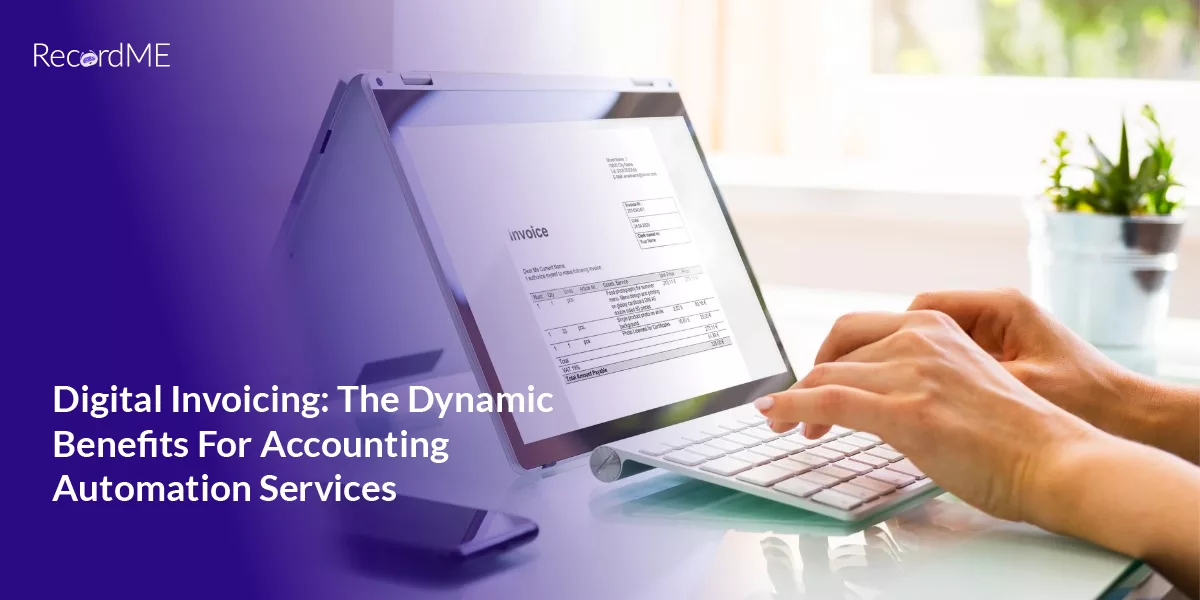An Expert Guide to Enhance Business Efficiency with Invoice Automation Solutions

In This Post
Managing business cash flow by Accounts Payable (AP) teams revolves around an efficient invoice processing system. When AP streamlines the payment process, it helps businesses benefit from supplier discounts, retain strong vendor connections, and fortify their financial position by managing liabilities carefully.
Unfortunately, a lot of companies still process invoices manually for various reasons. This includes receiving, entering, confirming statements, obtaining internal approvals, and addressing issues. Some people still refer to supplier receipts as paper invoices. Manual methods become impractical, slow, and expensive as firms adopt digital operations. Thus, invoice automation solutions are becoming more popular.
This article will define an automated invoice system, explain how it simplifies billing management, and explain how a finance department may apply it.
A Comprehensive Overview of Invoice Automation Solutions
An automated invoice system effortlessly extracts payment data, enters it into a system, and loads it into ERP for rapid payment processing. Traditional invoice processing takes too long by manually checking the bill against a sales agreement, uploading it to the system, marking, and paying it.
One step in the workflow automation procedure is digital invoicing. With invoice automation solutions, businesses may record, classify, and archive fax, scanned documents, email, and mobile receipts. Because of how the company is set up, only precise data will be entered into the financial accounts, reducing mistakes and saving time.
The accounts payable procedure is used to pay merchants and suppliers. To protect a business against financial scammers, companies need to have an advanced and automated accounts payable process.
What are the Steps for Invoice Processing?
The steps involved in processing invoices are as follows:
- Matching a Purchase Order (PO) with an invoice.
- Take a picture of the customer’s order and the delivery receipt and compare them to the invoice.
- Address any potential abnormalities (such as mismatched PO numbers, invalid items list, etc.).
- Forward invoices to the appropriate authorities for acceptance or rejection.
- Make purchases and update the company’s ERP system.
- Keeping track of payments and vendor bills for auditing purposes.
For their suppliers, employees, and investments, up to 30% of SMEs anticipate that late payments will have an adverse effect on their business.
How do Invoice Automation Solutions Improve Accounting Tasks?
Invoice automation solutions are an excellent investment for any business, even those who just handle a few monthly billing statements.
1) Reduce Manual Data Entry To Improve Accuracy
Employees find that entering data by hand is a never-ending activity that can lead to mistakes and incorrect calculations. But when businesses have an intelligent device dedicated to understanding the invoice process, the billing procedure becomes precise and quick.
Entering data from validated invoices into an ERP system is one of the main steps in the accounts payable procedure. It takes more time and increases the possibility of double entries and incorrect computations. 23% of businesses say inefficient procedures and manual data entry are significant challenges in the manual AP process.
Automated data entry is time-saving, almost correct, and efficient. Businesses can eliminate laborious and slow human operations by implementing automated invoices. Invoice automation software improves integration and productivity by directly extracting data from authorized receipts.
2) Perform Automated Invoice Audits and Matching
To prevent fraud, companies now need to use invoice matching. In 2022, it is projected that 65% of enterprises will fall prey to billing schemes and payment scams.
Using the AP component to validate invoices helps businesses avoid making duplicate or fraudulent payments. When done manually, verifications take time, and three-way authentication for missing PO numbers is challenging.
Two significant advantages of invoice automation solutions are an integrated accounting system and an automated payment approval workflow. AP automation lets the system match invoices, report discrepancies, and scan its primary database for POs and other supporting documentation. Businesses can look for open POs using their linked accounting systems with the AP process if the vendor eliminates the PO number.
3) Route Invoices to the Right Approvers
Since the AP team has appropriately recorded the invoice in the system, why not forward it immediately to the recipient, who has to approve it? For this, businesses must use invoice automation solutions.
In the manual forwarding process, the assigned employer contacts the manager to request invoice approval. This is typically a laborious process that results in delayed invoicing. According to a report, a single invoice might take up to 8.6 days to handle manually.
Businesses can automatically send invoices to the approver and receive follow-up alerts using AP customised invoice approval software. Because approvers may quickly evaluate and authorise bills, it significantly reduces the time for invoice approval.
4) Centralize Business Records
Traditionally, invoices are filed and kept in untraceable folders that are very challenging. On the other hand, every receipt, sales order, and inventory detail is stored in a designated and centralised database using invoice automation solutions.
Bills may be easily retrieved in case of necessity due to this centralised record system. It lessens the likelihood of missing bills, so there won’t be any more missed paperwork or tedious document searches. Accounting businesses can use cloud-based technologies to obtain automated invoices from any location.
5) Measure Performance and Foster Consistency
Accounting businesses may get early payment benefits and save processing costs with an efficient invoice approval process. Companies can identify invoice-related bottlenecks and analyse critical data across their workflows with the help of a digital invoicing platform, which facilitates the simplification of approval processes. KPIs allow them to monitor performance and adjust to improve overall sales optimisation. Workflow automation guarantees a positive supplier connection, streamlines the invoice process, and helps the account payable team meet deadlines.

A Step-By-Step Approach to Invoice Automation Solution
With the advancement of technology, the invoice processing process has gone through multiple phases. The question is, how can businesses in the current situation automate invoice processing?
When implementing invoice automation solutions, one can start with the four steps mentioned below:
-
Start by Analysing Current Invoice Processes
Ask the AP employees a few questions before deploying invoice automation systems, such as
- The recipient is who?
- How do they find them?
- How does their company handle invoices?
- Which invoice format, paper or electronic, is accepted for payments?
- What is the company’s typical invoice payment period?
These inquiries can clarify the current position of their organisation along the invoice process and the cost of managing bills. They will also be able to follow the inconsistencies and obstacles that cause errors and delayed payments. They can efficiently move to automated invoicing and correct the misconceptions after understanding the billing process.
-
Establish Invoice Policies and Processes
Establishing invoice policies and procedures ensures the billing automation procedure runs well. Protocols for carrying out customer orders and paying them are essential to simplifying automated invoices. If a method for receipt management is well defined, businesses may simply guide their present policies and strategies. Invoice automation solutions can establish a great workflow that payment handling software will automate by defining clear instructions.
-
Automate Invoice Tasks
A corporation must ensure the solutions it selects meet its requirements, even if many options are available to automate the billing process. Automated invoices may be received, processed, and paid for regardless of the business location due to cloud-based technologies used in invoice management applications. An integrated solution enables companies to grow their network and maintain global connections without the hassles of paperwork or mistakes.
-
Opt for the Best Automation Solution
Any company has to choose the right invoice processing solutions. It would be advisable to select an automation program that is compatible with the approval process. Businesses should be able to manage complaints, align with primary sources, automate invoice validation, and gather data for report generation with this solution.
Invoice processing software helps retain supplier confidence by allowing both parties to track payment status, choose payment options, and be transparent about the business. Invoices can be imported into the system through email, scanning, or manual entry, depending on the company’s preference. By combining all billing management into a single, central dashboard, invoicing software saves businesses time and frees them up to concentrate on other crucial areas of their operations.
Automate Your Invoice System with RecordMe
Do you want to stop submitting bills by hand every day? Businesses and individuals can use RecordMe‘s invoice processing service to eliminate error-prone and inefficient manual operations. An automated invoicing system offers companies a competitive advantage for precise and efficient financial management.
Through increased efficiency, accuracy, and security in financial management, RecordMe, an automated accounting platform, gives organizations a competitive edge and financial stability. Business cash flow and data entry problems are handled by it. Nobody will hinder a business from growing if it has a solid cash flow and strategy.
Are you still unsure of how automation could benefit your success in the contemporary digital environment? Get in touch with us!
Frequently Asked Questions (FAQs)
Q. What is an Automated Invoicing?
Automated invoice processing helps accounts payables teams receive, classify, and process invoices instead of manually entering data, generating paper documents, etc. Data extraction, workflow optimisation, and quicker approval of new or revised documents are all aided by invoice automation.
Q2) What is AI Invoice Processing?
AI invoicing helps speed up the approval process. The system specifies who must see the receipt at each stage of the approval process and when so that payment can be made on time. Tracking purchase orders that have not been approved is simple. The AI may also detect errors and send these for further evaluation before sending the invoice for final approval.
Q3) What are the Benefits of Automated Invoice Processing?
The following are the benefits of an automated invoice system:
- Quickly Access and Maintain Digital Data
- Real-Time Information
- Efficient Reporting Process



